Chapter 14: Case Study
Chapter learning objectives
The audit & assurance paper tests a range of practical andapplication skills. This case study helps to underpin core knowledge andto allow application of knowledge via a series of short exercises.
1 Background
The date is 15 November 20X7 and your audit firm (KPAD Co) has beenapproached by Bling Bling Co, a national chain of jewellers, to tenderfor their statutory audit for the year ending 31 December 20X7.
You are an audit manager working at KPAD and will be managing theaudit of Bling Bling if KPAD is appointed. KPAD is a large audit firmwith branches around the country and in Europe. The firm has over 500clients in many different industries.
You have a meeting scheduled with the Chief Executive Officer (CEO)and Finance Director (FD) of Bling Bling next week to discuss thecontract in more detail.
You have carried out some research on Bling Bling by reviewingtheir website, brochures and also by reading articles from the nationalpress, and have identified the following key points:
- Bling Bling was established 10 years ago and is owned and run by two entrepreneurs who have extensive experience in the jewellery industry.
- Bling Bling is a jewellers with 66 high street stores throughout England.
- They buy high value jewellery from Italy (mainly gold and silver) and sell it in their high street shops, on-line or to other jewellery retailers on a wholesale basis.
- The on-line business is relatively new and has been operating for just over one year.
- An article in the national newspaper in September 20X7 indicated that the price of gold was likely to fall dramatically during the following months due to an upturn in the world economy with major investors moving their funds out of gold and into other investment areas.
Points from meeting with the FD
- The FD informs you that Bling Bling has had another successful year and have opened another three stores at the start of 20X7.
- The directors have asked your firm to commence the audit immediately because audited accounts are needed by the bank by 5th February 20X8.
- Bling Bling would also like your firm to prepare their tax computations for the year in addition to the audit work.
- When asked why the previous auditors left, the CEO indicated that there had been a disagreement with the previous auditors about certain disclosures in the financial statements in the previous year.
Points from meeting with the KPAD audit partner
- Tom Parrott (partner of KPAD) would like to know more about the disagreement from the previous auditors .
- You conclude that the audit firm will have the skills to carry out the audit as it already audits another high street chain of jewellers. In addition, Tom's brother in law is a director at Bling Bling and should be able to assist with any difficulties the auditors have.
- Tom raises his concerns over staffing as it is a busy time of year for the audit firm.

 Test your understanding 1
Test your understanding 1
Engagement acceptance
Describe the matters to consider and the procedures that must beundertaken before accepting the appointment as auditor to Bling Bling.

2 Draft Financial Statements for the year ended 31 December 20X7
Bling Bling Co Draft Statement of Financial Position as at 31 December 20X7
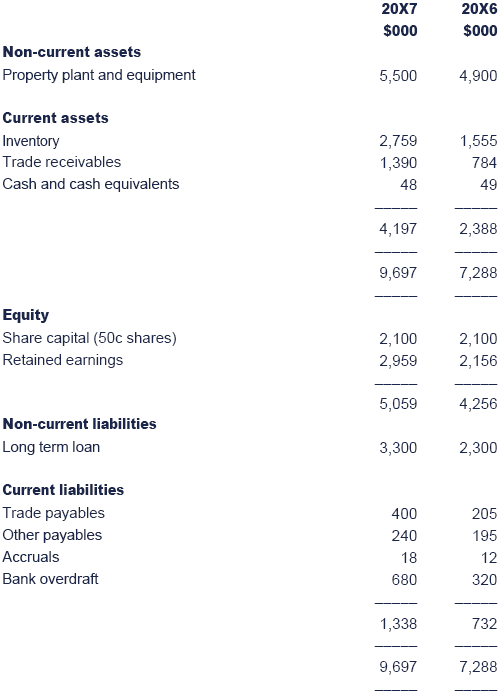
Bling Bling Co Draft Income Statement for the year ended 31 December 20X7
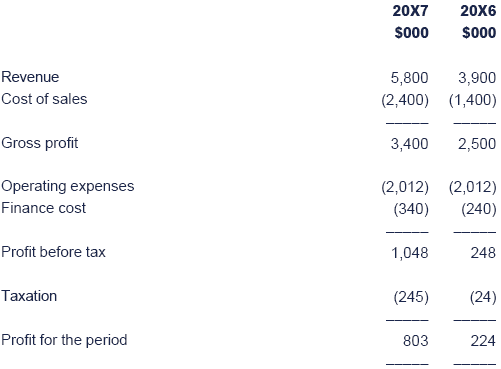

 Test your understanding 2
Test your understanding 2
Risk assessment
As part of your risk assessment procedures for Bling Bling, identify and explain possible audit risks using:
(a)your knowledge of the business; and
(b)analytical procedures.


 Test your understanding 3
Test your understanding 3
Non-current assets: property, plant and equipment note

Non-current assets substantive testing
You are in charge of auditing Bling Bling's non-current assets.
(a)What initial procedures would you perform on the non-current asset note?
(b)Which of the financial statement assertions are most relevant to the testing of motor vehicles?
(c)How would you test each of the assertions you have identified in (b)?


 Test your understanding 4
Test your understanding 4
Bank and cash substantive testing
The draft financial statements as at 31 December 20X7 show apositive cash balance of $48,000 and a bank overdraft of $680,000. Thereis also a long term loan of $3,300,000.
(a)What 3 documents would you obtain to prove,with reasonable certainty, that Bling Bling had a bank overdraft of$680,000 at 31 December 20X7?
(b)Rank these three documents in order of reliability.
(c)What would you do with these three documentsto prove, with reasonable certainty that Bling Bling had a bankoverdraft of $680,000 at 31 December 20X7?
(d)How could you prove the amount of cash (notes & coins) that Bling Bling held in its tills and safes at 31 December 20X7?


 Test your understanding 5
Test your understanding 5
Aged receivables analysis at 31 December 20X7 ($000)
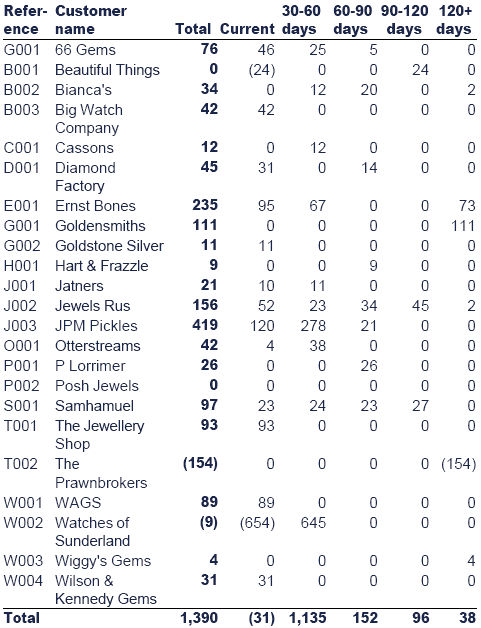
Trade receivables substantive testing
(a)State and briefly explain three assertions associated with the audit of trade receivables.
(b)Select four balances that should be includedin your trade receivables direct confirmation audit testing. Explainwhy you have included each of the balances.
(c)Apart from direct confirmation, state andexplain six substantive procedures the auditor should perform on theyear-end trade receivables of Bling Bling.


 Test your understanding 6
Test your understanding 6
Inventory substantive testing
You attended the physical inventory count at Bling Bling's year endof 31 December 20X7. The company does not maintain book inventoryrecords, and previous years' audits have revealed problems withpurchases cut-off.
Your audit tests on purchases cut-off, which started from the goods received note (GRN), have revealed the following results:
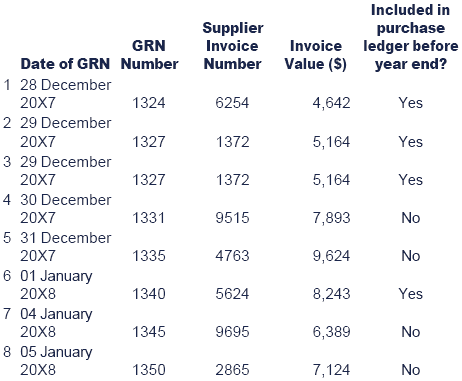
Assume that goods received before the year end are in inventory atthe year end, and goods received after the year end are not in inventoryat the year end.
From the results of your purchases cut-off test described in the question:
(a)Identify the cut-off errors and produce aschedule of the adjustments which should be made to the reportedpurchases and payables in the draft financial statements to correct theerrors.
(b)Comment on the results of your test, and state what further action you would take.


 Test your understanding 7
Test your understanding 7
Payables substantive testing
You are now auditing the company's trade payable balance of £400kat 31 December 20X7. The total balance has already been agreed to thepurchase ledger which shows that trade payables consists of 5 suppliers.
A junior member of the audit team has been checking these 5balances by reconciling suppliers' statements to the balances on thepurchase ledger. He is unable to reconcile a material balance, relatingto Geminite, who supply gold jewellery to Bling Bling. He has asked foryour assistance, and your suggestions on the audit work which should becarried out on the differences.
The balance of Geminite on Bling Bling's purchase ledger is shown below:
Purchase ledger Supplier: Geminite Co
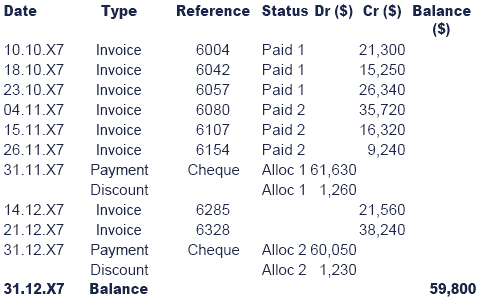
Geminite Co have sent the following supplier statement:

Geminite's terms of trade with Bling Bling allow a 2% cash discounton invoices where Geminite receives a cheque from the customer by theend of the month following the date of the invoice (i.e. a 2% discountwill be given on November invoices paid and received by 31 December).
On Bling Bling's purchase ledger, under 'Status' the cash anddiscount marked 'Alloc 1' pay invoices marked 'Paid 1' (similarly for'Alloc 2' and 'Paid 2').
Bling Bling's goods received department checks the goods when theyarrive and issues a goods received note (GRN). A copy of the GRN and thesupplier's advice note is sent to the purchases accounting department.
Required:
(a)Prepare a statement reconciling the balance on Bling Bling's purchase ledger to the balance on Geminite's supplier's statement.
(b)Describe the audit work you will carry outon each of the reconciling items you have determined in your answer topart (a) above, in order to determine the balance which should beincluded in the financial statements.

Test your understanding answers

 Test your understanding 1
Test your understanding 1
The firm needs to consider a variety of commercial issues and ethical matters (under ACCA's Rules of Professional Conduct).
Matters to consider. Before accepting appointment the firm should ensure that:
- It has the necessary staff with appropriate competencies to complete the audit (this seems likely given that the firm has another client in the jewellery industry).
- The staff are available at what is a busy time of year for the firm (it may be possible that all of the staff with the necessary competencies are otherwise occupied).
- The firm is independent of Bling Bling. Tom Parrott will not be able to partner the audit due to the family relationship he has with one of the directors. KPAD will need to ensure there are no shareholdings or other relationships that may comprise independence.
- There are no conflicts of interest that cannot be properly managed. This is a potential issue as KPAD already audit another high street jewellers. However, as the firm is large with many different branches across the country it should be possible to put in place appropriate safeguards.
Procedures. The firm should:
- Seek the directors' permission to communicate with the company accountant about the nature of the 'disagreement' and the directors should authorise the accountant to co-operate with the firm.
- Seek the directors' permission to communicate with the outgoing auditors. If permission is refused, the appointment should not be accepted.
- Ask the client to write to the outgoing auditors notifying them of the change and giving them permission to communicate with the firm (if Bling Bling refuses to give permission to the outgoing auditors the appointment should not be accepted).
- Communicate with the outgoing auditors (preferably in writing) requesting all the information which ought to be made available to enable the firm to decide whether or not to accept the appointment (if there are no such matters, the outgoing auditors should inform the firm of this).
- Indicate a likely fee (or the basis on which fees are calculated) to Bling Bling, ensure that this is acceptable and that the client is able to pay (by some form of credit check).
- Ensure that the outgoing auditor has properly resigned, been dismissed or has not sought re-appointment in accordance with legal requirements.


 Test your understanding 2
Test your understanding 2
(a)Audit risks found using knowledge of the business:

(b)Audit risks found using analytical procedures:
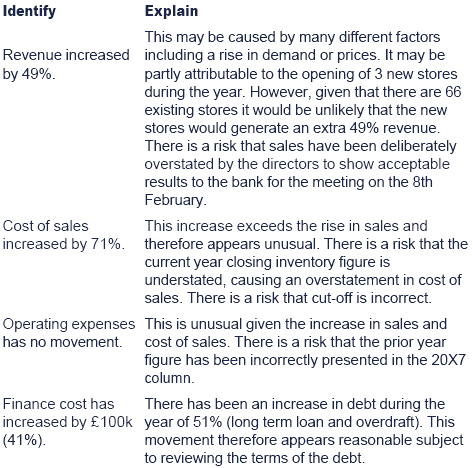
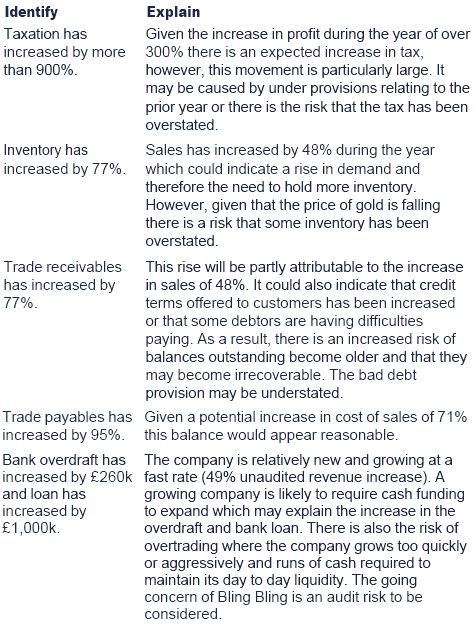


 Test your understanding 3
Test your understanding 3
(a)Initial procedures
- Agree opening cost, depreciation and NBV to last years audited closing balances to ensure they have been brought forward accurately. As PKAD were not the auditors in the previous year they may need to consider if any of their own audit work should be conducted on these opening balances.
- Cast (add up) the note to ensure there are no arithmetical errors.
- Agree the total on the note to the trial balance and the financial statements to ensure that it is accurate and complete.
- Compare the disclosure of the note in accordance with the requirements of the International accounting standards to ensure it is adequate.
(b)Assertions
Completeness – have all the vehicles that should have been recorded been recorded?
Accuracy – have amounts been recorded and disclosed appropriately?
Existence – do the vehicles actually exist?
Rights and obligations – does the entity hold or control the rights to the vehicles?
Valuation and allocation – are vehicles valued appropriately in the financial statements?
(c)Audit tests
- During the physical inspection for existence, record details of some vehicles and ensure those vehicles are recorded in the non-current asset register.
- Identify the supplier of the vehicles from a purchase invoice. Obtain all invoices from this supplier and confirm completeness of recording in the non-current asset register.
- For a sample of vehicles from the ledger, confirm existence by physically seeing the vehicle.
- Examine a sample of purchase invoices to confirm ownership of the vehicles.
- Review company policy for depreciation. Confirm with amount charged in similar companies that the depreciation percentage appears to be correct.
- Agree depreciation charged in the non-current asset note to the amount on the profit and loss account.
- Check a sample of depreciation calculations to ensure that they are accurate and that they conform to company policy.


 Test your understanding 4
Test your understanding 4
(a)Three documents to assist an auditor wouldbe the clients bank reconciliation, the bank statements and also a bankconfirmation letter. The bank confirmation letter is a reply directly tothe auditor from the bank that details the accounts and balances thatare held at a bank by a particular client. It will also detail any longterm loans that are owed together with any other relevant informationsuch as any security held by the bank over outstanding loans.
(b)In order of reliability the bankconfirmation letter is the most reliable evidence, the bank statementsnext and finally the bank reconciliation is the least reliable source ofevidence.
The bank confirmation letter is the most reliable as it a thirdparty document that has been generated at the request of the auditor andsent directly to the auditor without the client being involved, apartfrom providing authorisation to the bank to disclose such information tothe auditor.
The bank statements are next in order of reliability as althoughthey are third party documents they are usually provided to the auditorby the client – i.e. the bank sends the statements to the client(Bling Bling) who pass them on to the auditor to review during theaudit. Any documents that pass through the hands of the client will beless reliable as there is the risk, however small, that the client willalter the documents to fulfil their own objectives.
Finally the bank reconciliation is the least reliable as it is aclient generated document. As such this source document cannot be fullyrelied upon and further audit evidence will be sought to confirm itsaccuracy.
(c)Audit procedures:
- Cast the bank reconciliation to confirm arithmetical accuracy.
- Trace and agree the bank statement balance on the bank reconciliation to an original bank statement and also to the bank confirmation letter.
- Trace and agree all unpresented cheques and outstanding lodgements on the bank reconciliation to post year end bank statements to ensure that they have cleared in a reasonable timeframe.
- Trace and agree the cash book balance on the bank reconciliation to Bling Bling's actual computer accounting records.
- Scrutinise the bank confirmation letter to ensure that no other bank accounts exist.
(d)The auditor should plan to attend all/someof Bling Bling's shop's on the last day of year to observe counting ofall cash on the premises. This can then be verified to a list ofyear-end cash balances during the final audit.


 Test your understanding 5
Test your understanding 5
(a)Assertions
NB: Only four assertions are given, for example purposes.
- Existence – does the receivable and the amounts listed as outstanding actually exist
- Rights & obligations – does Bling Bling have the right to receive the outstanding amounts from each customer to settle legitimate outstanding invoices
- Accuracy – does the trade receivable listing add up and are individual ledger balances arithmetically accurate
- Valuation – are the trade receivable balances stated at the appropriate carrying value, net of any bad debt write offs or provisions.
(b)Balances selected for testing
- JPM Pickles – The outstanding balance is over 30% of the total receivables outstanding at the year end and is therefore material. Errors in this account may result in a material error in the account balance as a whole.
- The Prawnbrokers – The large and old credit balance on the listing suggests an error has been made in this account. A payment from another customer may have been misallocated to this account or a the client may have over or double paid an invoice.
- Goldensmiths – This large and old balance may require write off or a specific provision to be made if the recoverability of the amount is in doubt.
- Watches of Sunderland – Although the outstanding amount is small the credit balance appears to be due to a difference between a recent large payment and the outstanding balance. The error may indicate other potential errors that have taken place in this account.
There are several other balances that could be identified andjustified in your answer for similar reasons to the above answers. Theseinclude Beautiful things, Ernst Bones and Jewels R us.
(c)Audit tests
- For a sample of outstanding balances at the year end trace and agree receipts from the customer shown in the receivables ledger after the year end to the cash book and bank statements.
- For any amounts over 90 days old at the year end that have not subsequently been received discuss with the client the need for write offs or the provision for irrecoverable receivables.
- For a sample of invoices raised just before and just after the year end trace to the relevant goods dispatch note and confirm that the sale has been recorded in the correct period to ensure the cut-off has been applied correctly.
- Cast and agree the arithmetical accuracy of the receivables ledger and a sample of individual accounts.
- Trace and agree the balance on the receivable listing to the draft financial statements.
- Verify the opening balance on the receivables ledger matches the closing balance on the prior year ledger and the prior year financial statements.
- Discuss with management the assumptions underlying any general provisions to ensure reasonable and appropriate.
- Recalculate the general provision based on management's assumptions and agree the figure to the draft financial statements.


 Test your understanding 6
Test your understanding 6
(a)In the list of items given in the question,purchases cut-off is correct for items 1, 2, 7 and 8. So the adjustmentsto profit are:

(b)The test has highlighted four errors in asample of 8 items, an error rate of 50%, which is very high. With thehigh error rate, there is evidence of serious purchases cut-off errors,and to quantify the potential error, a larger sample of items should beselected, covering a longer period. It is suggested the period shouldcover two weeks before the year end to two weeks after the year end, anda greater proportion of GRN's should be selected.
If there are cut-off errors at the end of these periods (i.e. twoweeks before the year end and two weeks after the year end), the periodfor checking cut-off should be extended. In addition, the company'smanagement should be notified of the problem. They could help bychecking cut-off and giving me a schedule of the items they have checkedand the errors they have found.
As further checks of purchases cut-off, I would check purchaseaccruals at the year end. They should be for goods received before theyear end which have not been included on the purchase ledger before theyear end. A purchase accrual should not be included where:
- goods are received before the year end and the purchase invoice has been posted to the purchase ledger before the year end; or
- goods are received after the year end.
In addition I would check the reconciliation of suppliers'statements to the balances on the purchase ledger, and investigate anydifferences. For instance, if there are invoices on the supplier'sstatement which are not on the client's purchase ledger, I will checkthe goods were received after the year end (if they were received beforethe year end, and were not included in purchase accruals, there wouldbe a purchases cut-off error). This work should quantify the totalpurchases cut-off error, which should be included in the summary ofunadjusted errors in my audit working papers.


 Test your understanding 7
Test your understanding 7
(a)Reconciliation of purchase ledger balance to balance on supplier's statement:
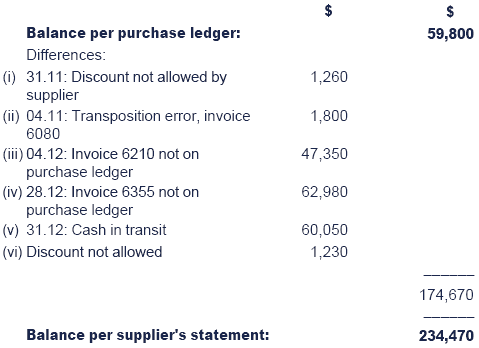
(b)Looking at each of the items above:
(i)The date of the cash payment forthe October invoices suggests that Geminite will not have received thecheque for £61,630 until after the 30 November and so Bling Bling maynot be entitled to the 2% cash discount. The date the cheque was bankedby Geminite can be found by looking at Bling Bling's bank statement andchecking the date it was cleared by the bank. The entry in Bling Bling'sledger suggest the cheque was posted on 30 November however this is notconclusive evidence that the cheque was actually sent to Geminite onthis date. Neither is the date of clearance at the bank conclusive proofof when the cheque was actually received by Geminite. To establish thevalidity of the discount I will ask Bling Bling's purchase ledgercontroller about this item, and inspect correspondence with Geminite. IfBling Bling usually pays this disallowed discount to Geminite, thisdisallowed discount should be added to the purchase ledger balance. IfGeminite eventually allows the discount, there is no need to add thediscount to the balance.
(ii) The apparent transposition erroron invoice 6080 would be checked by inspecting the invoice. If theinvoice shows $37,520, then an additional payable of $1,800 should beadded at the year end to correct this error. No adjustment will benecessary if Bling Bling's figure is correct.
(iii)It appears that invoice 6210 for£47,350 has not been included on Bling Bling's purchase ledger. As thisinvoice is dated some time before the year end, the first question toask is whether the goods have been received. I will check whether thegoods have been received by looking for the appropriate goods receivednote (I may have to ask Geminite for details of this item, if no invoicecan be found at Bling Bling). If the goods have been received, I willcheck if there is a purchase invoice. If there is a purchase invoice, Iwill ask the purchases department why the invoice has not been posted tothe purchase ledger. This may be because of a dispute, possibly eitheran incorrect price, the wrong quantity or some faults with the goods. Ifthe goods relating to this invoice are in inventory (or have been sold)a purchase accrual should be made for this item. If there has been ashort delivery, the purchase accrual would be for the actual goodsreceived, rather than for those on the invoice. I will inspectcorrespondence relating to this invoice with Geminite to assess whatwill be finally agreed. If there is no evidence of the goods beingreceived by Bling Bling, I will ask Geminite for details confirming thatBling Bling has received the goods. If there is no evidence that BlingBling has received the goods, then no purchase accrual for this invoiceis necessary.
(iv)For invoice 6355, the key questionis likely to be whether Bling Bling received the goods before the yearend. I will check if Bling Bling received the goods before the year endby looking at the date on the goods received note. If the date is beforethe year end, then Bling Bling should include a purchase accrual at theyear end for this invoice.
(v) The cheque on 31 December appearsto be cash in transit. I will check the date the cheque is cleared bythe bank after the year end. If this is within a week, and most othercheques are cleared within a week, then this is validly cash in transit.If most cheques issued immediately before the year end take more than aweek to clear, it indicates they were sent to suppliers after the yearend, in which case they should be deducted from payments before the yearend and added to payables (as these were payments made after the yearend).
(vi)If, as appears likely, the chequefor £60,050 is not received by Geminite until some time after the yearend, then the discount of $1,230 may be disallowed by Geminite. If thisdiscount is disallowed, it should be added to payables at the year end.Checks on this item are similar to those for item (i) above.

 |
 |
 |
|
Created at 5/24/2012 2:40 PM by System Account
(GMT) Greenwich Mean Time : Dublin, Edinburgh, Lisbon, London
|
Last modified at 5/25/2012 12:54 PM by System Account
(GMT) Greenwich Mean Time : Dublin, Edinburgh, Lisbon, London
|
|
|
|
 |
Rating
:
|
 Ratings & Comments
(Click the stars to rate the page) Ratings & Comments
(Click the stars to rate the page)
|
 |
Tags:
|
|
|
|
|